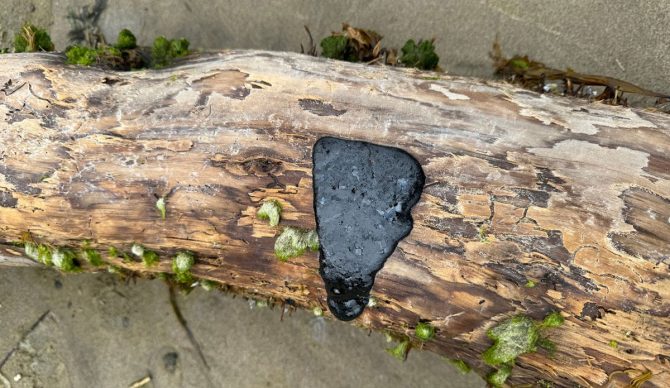
If you see something like this, don’t touch it. Obviously. Photo: Oregon Department of Environmental Quality
If you happen to be taking a beach stroll in Oregon or Washington, you might see something a little odd. Patties of an oily, tar-like substance are washing up on beaches on over 150 miles of coast If you do, though, don’t touch the tar balls, because authorities aren’t exactly sure what they are
California residents might recognize them as tar balls, which are a relatively common sight, especially in Central California in the winter months.
They are “often remnants of oil spills but can also be produced from natural seeps, places where oil slowly escapes from the earth surface above some petroleum reservoirs,” the National Oceanic and Atmospheric Administration (NOAA) explains. “When crude oil (or a heavier refined product) floats on the ocean surface, its physical characteristics change. During the first few hours of a spill, the oil spreads into a thin slick. Winds and waves tear the slick into smaller patches that are scattered over a much wider area. Various physical, chemical, and biological processes change the appearance of the oil. These processes are generally called ‘weathering.'”
But tar balls are not common sights from Long Beach, Washington, down to Waldport, Oregon, where the little black blobs have been appearing.
ODFW is working with federal and state agencies in response to reports of wildlife contaminated by a tar-like substance from an unknown source along the northern Oregon and southern Washington coasts. Learn more: https://t.co/vkJVkk7M0K pic.twitter.com/rcIIrt6WaS
— Oregon Department of Fish and Wildlife (@MyODFW) May 24, 2024
Cleanup teams have been dispatched and more than a few birds have been found struggling with the gunk. Sadly, a handful of a birds called common murres have died because of it.
“What exactly they’ve been contaminated by is unclear,” IFLScience writes. “Both state and federal agencies have been testing the substance and have so far been able to determine that it’s petroleum-based.”
While it does seem like a good bet the blobs are similar to California’s tar balls, the source of them is a mystery. Responders from the U.S. Coast Guard, the Oregon Department of Environmental Quality, and the Washington Department of Ecology plan to conduct an aerial surveillance mission in hopes of pinning down where the tar is coming from, but they don’t want the public’s help.
“Multiple oil spill response organizations with trained personnel and equipment are actively working to address impacted areas and priority, high-visitation sites,” the Department of Environmental Quality writes in a press release. “Please leave cleanup to professional responders who are trained and equipped to handle this type of material.”
Test results won’t be back for a week or so. In the meantime, try not to get them between your toes, because tar balls stuck to your feet is just the worst.

